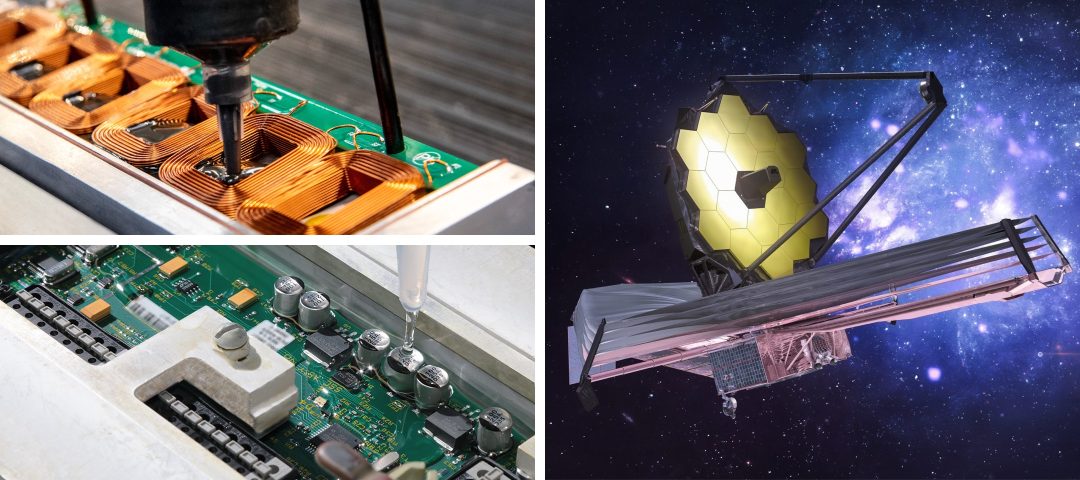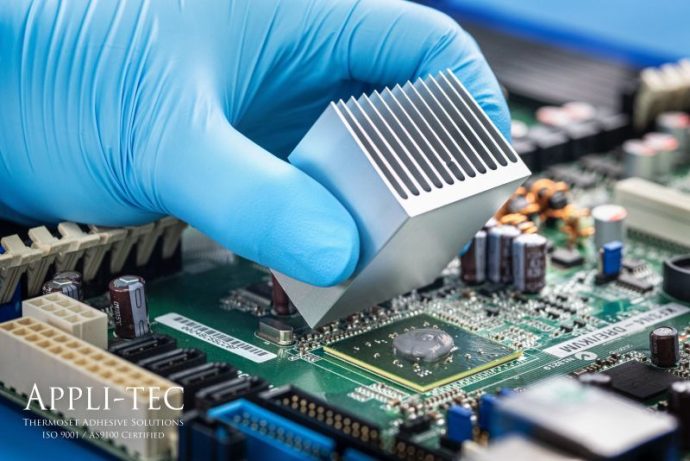Search this site
Potting Compounds: Properties to Consider for Aerospace, Optical, and Industrial Applications

Potting compounds serve many purposes, including protecting electronics, coils, and circuit boards from shock, thermal cycling, or environmental conditions. They also protect IP.
Customers who contact Appli-Tec do so because they need an advanced adhesive that meets specific requirements for their specialized applications – which can range from optics in radar systems to sensors in industrial anemometers.
The chart shows some of the requests we’ve received for potting compounds. As you can see, engineers can have complex application challenges. Our job, therefore, is to ask lots of questions to ensure we recommend the right material based on its properties and behaviors under specific conditions.
| Application Challenge | Suggested Compound | Why |
|---|---|---|
| “We’re potting an electronics enclosure to make it vibration and waterproof.” | Appli-Thane 7125 |
|
| “End-sealing of optical lens assemblies; need a material with low MVTR, low outgassing, & withstand thermal cycling.” | Appli-Thane 7810 |
|
| “We’re encapsulating a circuit board that will be exposed to outdoors as well as salt and other industrial fluids.” | 5032 Epoxy |
|
| “Converter contains a transformer that dissipates a lot of heat, need an epoxy potting compound with very high thermal conductivity.” | 5380 Epoxy |
|
| “Circuit board needs to survive being immersed in deionized water for several years.” | 5108 Epoxy |
|
Seven properties to consider when choosing a potting compound
As you can see, choosing the right potting compound requires more than simply choosing a material type (e.g. epoxy, polyurethane, or silicone) and/or viscosity. You also have to consider the application, the environment in which it will be used or subjected to, and the shape and structure of the assembly – as well as any attached smaller components.
Another consideration is whether you own an ultra-low temperature freezer to store pre-mixed and frozen adhesives; if not, material choice is limited to two-part kits.
Each property listed below can be found on Appli-Tec’s Technical Data Sheets (TDS), which you can easily download without having to complete a form from our Adhesive Materials & TDS page.
Thermal conductivity
Generally, potting compounds don’t need to be thermally conductive, since circuit boards, coils and transformers are being potted or encapsulated to protect from shock or environmental conditions (moisture, water, solvents, salt, etc.).
However, heat is a detriment to performance. If a component or the assembly itself produces heat, you’ll need a potting compound that’s thermally conductive in order to dissipate it. The more heat generated, the higher the thermal conductivity needed.

Appli-Tec has six thermally conductive potting compound materials – ranging from 3.2 W/mK to 1.11 W/mK – depending on how aggressively you need to dissipate heat. Our 5380 Epoxy (pictured), for example, delivers high thermal conductivity, good flowability, and long pot life. It also meets NASA’s low outgassing requirements.
Viscosity
How easily an epoxy or urethane needs to flow is dependent on your application and how the potting material is being applied. For example, does the material need to flow quickly — like maple syrup? Or, does it need some thixotropy because it has to hold its shape after application?
Outgassing
Materials often need “airing out” so that odors dissipate. When you paint a room, for example, you open the windows. In effect, you’re allowing the paint to off-gas.
In space, however, removing outgassed compounds is much more serious and complicated. According to NASA, “gases can resettle, coating nearby surfaces with a film, potentially obstructing sensors, cameras, and other optical equipment.” (Read the full discussion at the NASA website.)

Outgas film on windshield
NASA’s official low-outgas standard, to which Appli-Tec adheres, is ASTM E595 for Non-Metallic Materials. All Appli-Tec Potting Compounds listed on our website pass this requirement. In fact, two of our materials are listed in NASA’s low outgassing database: 5200 Epoxy and 5010 Epoxy.
Whether your application is in space, the factory, or outdoors, you’re assured of a very clean potting material that won’t cause nearby sensitive components to be obstructed or covered in a film.
Color
Material color is dependent on customer requirements. Companies wanting to protect IP will often choose black in order to hide components and other information.
Applications that include optics, such as radar systems or doorbell cameras, may require an optically clear adhesive, such as 5032 Epoxy.
Work life and Pot life
Pot life refers to the amount of time required for a material to reach double its initial viscosity. Timing for pot life begins when a frozen material reaches approximately 18°C or ambient conditions.
Pot life is a number generated in the lab and is included on technical data sheets (TDS) to help engineers compare adhesive reaction rates. Work life refers to the amount of time a thawed material retains the correct viscosity for it to be properly applied to a part or substrate.
Work life can be shorter or longer than the pot life and is application-specific. For example, if an application can tolerate a viscosity higher than double the initial viscosity, then the work life for the adhesive for that application will be longer than the pot life.
(See our Adhesive Tech Tip: Maintaining Adhesive Viscosity and Work Life.)
Modulus
Modulus refers to how stiff a potting material is once it’s cured. Depending on your application and assembly / component type, we can recommend a material that’s either soft, and won’t harm components, or rigid – meaning it can’t be damaged or removed.
Robustness
While not a property listed on our TDS, Robustness refers to how well the material withstands exposures and maintains its properties over the life of the part – and is thus a key consideration when one of our Technical Specialists recommend a potting compound to you.
Have a question about potting (or encapsulating) an assembly or component for a specific application? Send your question to one of our technical specialists — see the Contact information below.
New Applications
I want to discuss my application challenges, order samples, or place a first-time order.
Existing Applications
I need to reorder an existing part number, I have a BOM/Spec.

